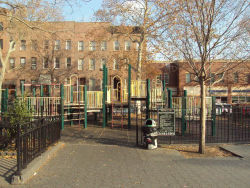Carroll Park
Louis Valentino, Jr. Ballfield
This ballfield was named in honor of firefighter and lifeguard Louis Valentino Jr. (1958-1996) under a local law introduced by Councilmember Stephen DiBrienza and signed by Mayor Giuliani on June 25, 1996. Beginning with his early years in Red Hook and Carroll Gardens--where he attended Sacred Heart St. Stephens--Valentino lived and studied in a number of Brooklyn neighborhoods. A graduate of Xaverian High School in Bay Ridge and St. Francis College in Brooklyn Heights, he was living in Bensonhurst at the time of his death.
Valentino fulfilled his lifelong aspiration to become a firefighter when he joined the Fire Department in 1984. He was assigned to Engine Company 281 where he battled fires for two years. He was twice cited for his bravery, in 1987 and again in 1990, and served with Ladder Company 147 in Flatbush. Valentino was accepted to the elite Rescue Company 2 in Crown Heights in 1993, joining the ranks of the city’s most experienced and versatile firefighters.
On February 5, 1996 Valentino was killed while searching for wounded firefighters in a three alarm blaze in an illegal Flatlands garage. A Brooklyn mechanic who caused the fire was convicted of murdering Valentino on December 2, 1996. The Louis Valentino Jr. Ballfield preserves the memory of a man who not only demonstrated selfless devotion to fighting fires and saving lives but was also renowned for his prowess as a member of the Fire Department softball team.
CARROLL PARK 1.874 Acres
Brooklyn’s third oldest park is named for Charles Carroll (1737-1832), an American Revolutionary leader and signer of the Declaration of Independence, for whom Carroll Street is also named. He served in the Continental Congress from 1776-78, represented Maryland in the Senate from 1789-92 and also led a Maryland regiment that defended the Old Stone House in Park Slope.
The park originated in the late 1840s as a private community garden shortly after much of the neighborhood, which now comprises the Carroll Gardens Historical District, was laid out by surveyor Richard Butts. The land was acquired for use as a public park by the City of Brooklyn in 1853. It was first improved around 1870 when a drainage system was installed, a children’s playground was built, and new walks were laid. Subsequent renovations in the 1890s, 1930s, and 1960s introduced new design features and playgrounds, which increased opportunities for active recreation.
In 1994 Carroll Park underwent a $1.3 million capital reconstruction and redesign, funded by Borough President Golden. Improvements included new plantings, reorganization of the playspaces and the installation of play equipment. The historic character of the park was also restored with decorative cast iron gates and fencing that echo the fences of neighborhood brownstones and motifs on the bronze and granite Soldier and Sailors World War I Monument (1920) by sculptor Eugene H. Morahan that was conserved under the same project. Community involvement in the programming, maintenance, and preservation of the park has been ensured by the Committee to Improve Carroll Park (first formed in 1975), in partnership with City of New York/Parks & Recreation.
Check out your park's Vital Signs
Clean & Safe
Green & Resilient
Empowered & Engaged Users
Share your feedback or learn more about how this park is part of a
Vital Park System


